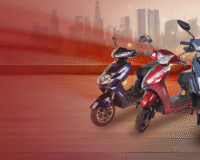In today’s fast-paced world, electric two-wheelers have become a popular and eco-friendly mode of transportation. At the heart of these sleek machines lies a powerful technology – the battery. Understanding electric scooter batteries is essential for maximizing their performance and making informed choices. In this blog, we will delve into the types of batteries used in E2Ws, their charging mechanisms, and how battery technology plays a pivotal role in determining range and performance.
All About Electric Scooter Batteries
Let’s demystify the world of electric two-wheeler batteries!
1. Types of Batteries
Electric scooters primarily use two types of batteries: lithium-ion (Li-ion) and lead-acid batteries. Let’s explore the characteristics of each:
- Lithium-ion (Li-ion) Batteries
These batteries are known for their high energy density, lightweight nature, and longer lifespan. They consist of a cathode, anode, separator, and electrolyte. Li-ion batteries are commonly used in modern E2Ws due to their efficiency and compact size. They provide a better power-to-weight ratio, enabling longer rides and faster acceleration. - Lead-Acid Batteries
While these are less common in modern electric two-wheelers, lead-acid batteries were used extensively in earlier models. They are heavier and less energy-dense compared to Li-ion batteries, resulting in shorter ranges and slower acceleration. However, they are more cost-effective and can withstand deep discharges.
2. Charging Mechanisms
Charging an electric scooter battery is a straightforward process, but it’s important to follow manufacturer recommendations:
- Standard Charging
Most E2Ws come with a standard charger that can be plugged into a regular household outlet. Li-ion batteries have a built-in Battery Management System (BMS) that ensures safe and balanced charging. - Fast Charging
Some scooters support fast charging, allowing you to charge the battery to a significant level in a short time. However, frequent use of fast charging may slightly reduce the battery’s overall lifespan. - Swappable Batteries
Certain scooter models have swappable batteries, enabling users to replace a depleted battery with a fully charged one. This approach is gaining popularity as it minimizes downtime due to charging.
3. Battery Technology’s Influence on Range and Performance
Battery technology has a profound impact on an electric two-wheeler’s range and performance:
- Range
The energy capacity of the battery directly affects how far you can travel on a single charge. Li-ion batteries, with their higher energy density, generally offer longer ranges compared to lead-acid batteries. - Performance
Battery technology influences a scooter’s acceleration and speed capabilities. Li-ion batteries deliver higher power output, resulting in better acceleration and overall performance. - Weight
Li-ion batteries are lighter than lead-acid batteries, reducing the overall weight of the scooter. This contributes to better maneuverability and efficiency. - Lifespan
Li-ion batteries usually have a longer lifespan compared to lead-acid batteries. Proper charging practices, temperature control, and maintenance can further extend a battery’s life.
Conclusion
Electric two-wheeler batteries are the driving force behind the revolution in urban mobility. Understanding the types of batteries, their charging mechanisms, and their impact on range and performance can help users make informed decisions when choosing an electric scooter. As technology continues to advance, we can expect even more efficient and powerful batteries, further enhancing the riding experience. At e-Sprinto, we’re committed to providing cutting-edge battery technology that empowers riders to embrace the future of sustainable transportation.






